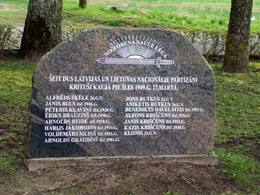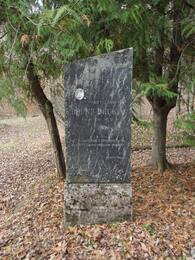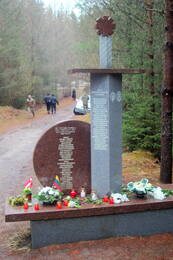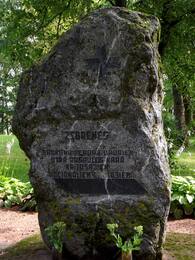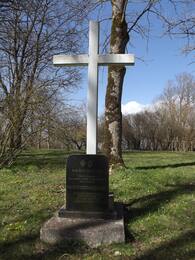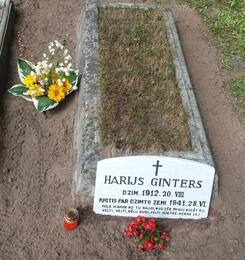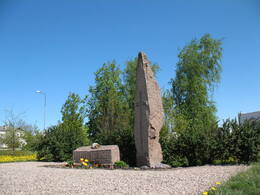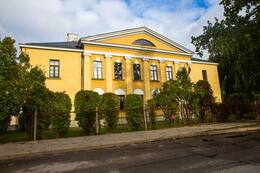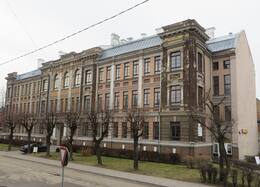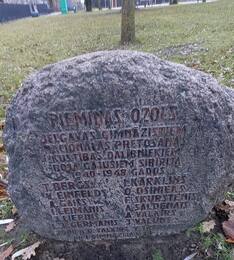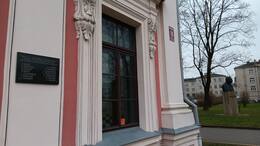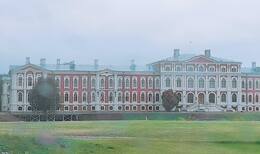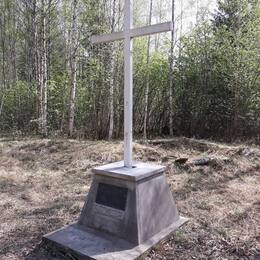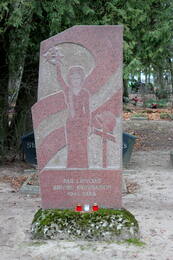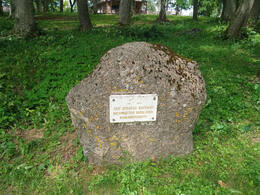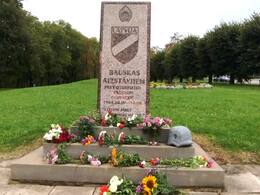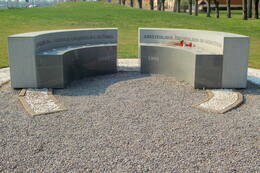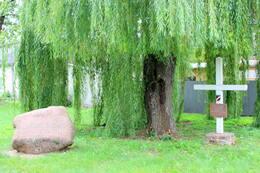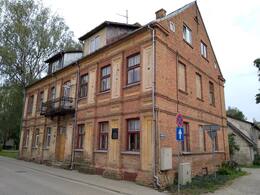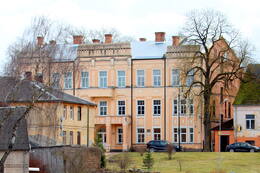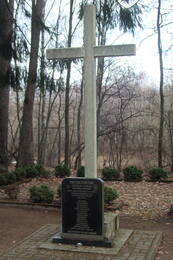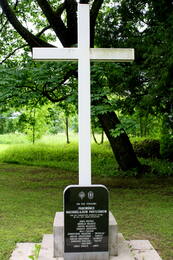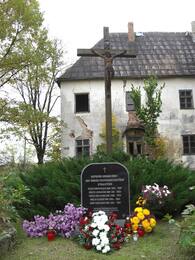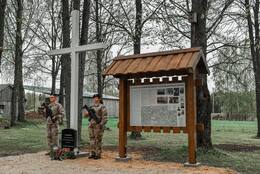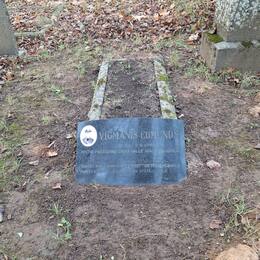Widerstand gegen das sowjetische Besatzungsregime in Zemgale
Das Grab der Brüder der nationalen Partisanen von Íle auf dem Virkus-Friedhof der Gemeinde Birze
Das Brüdergrab der Nationalen Partisanen von Íle wurde am 14. November 1992 auf dem Virkus-Friedhof der Gemeinde Birze errichtet, als hier 15 Partisanen begraben wurden, die in der Schlacht von Íle am 17. März 1949 gefallen waren. Dies war möglich, nachdem die Nationalgarde am 18. Juli 1992 zusammen mit der Organisation „Daugavas Vanagi“ und der lettischen Geschichtsforschungsarbeitsgruppe „Ziemeļblāzma“ unter Beteiligung von Vertretern anderer national ausgerichteter Organisationen die begrabene Person exhumiert hatte der gesprengte Partisanenbunker im Waldgebiet Īle der Gemeinde Zebrene. Die sterblichen Überreste von 15 lettischen und litauischen Waldbrüdern.
Der Gedenkstein für die in der Schlacht um die Île gefallenen nationalen Partisanen wurde am 29. Mai 1993 eingeweiht. Es basiert auf der Meta, die von Alfons Kalniņš („Edgars“), einem der überlebenden Teilnehmer der Schlacht vom 17. März 1949, entwickelt wurde. Eine regelmäßig geformte Granitplatte zeigt ein Schwert und eine aufgehende Sonne sowie einen Inschrifttext mit den Namen von 15 gefallenen nationalen Partisanen und einer Inschrift:
„Die Sonne ging aus dem Schwert auf. Hier starben 1949 die nationalen Partisanen Lettlands und Litauens in der Schlacht nahe der Île. am 17. März“.
Der Grabstein des 1941 verstorbenen nationalen Partisanen Bruno Druķas auf dem Jaunsesava-Friedhof der Gemeinde Naudīte
Grabdenkmal für den nationalen Partisanen der Gemeinde Naudīte, Bruno Druķis, der am 30. Juni 1941 bei einem Zusammenstoß mit den bewaffneten Formationen der sowjetischen Besatzungsmacht fiel. Auf dem Grab ist eine Granitstele mit dem Text „Für den Partisanen Bruno Druķis“ angebracht. Fiel 1940.30.VI. Dieses Land ist ein heiliges Erbe für unser Volk. Und gesegnet ist, wer vor ihm sicher ist. Naudīte-Gemeinde“. Das Keramikmedaillon mit dem Porträt von B. Drukis wurde nach dem Zweiten Weltkrieg zerschlagen und zerstört.
Nach Beginn des Deutsch-UdSSR-Krieges, am 27. Juni 1941, versammelten sich etwa zehn lokale Verteidiger im Ruženi-Wald und bildeten eine nationale Partisaneneinheit mit Zhan Gelson an der Spitze. Am nächsten Tag besetzten die Partisanen das Exekutivkomitee der Gemeinde Naudīte und die örtliche Maschinen- und Pferdevermietung und beschlagnahmten die dortigen Traktoren, landwirtschaftlichen Geräte und Pferde. Am 30. Juni versuchte die Partisaneneinheit von Naudīte, eine von zwei Offizieren angeführte Kolonne von Soldaten der Roten Armee auf der Straße in der Nähe von Melļi festzuhalten. Während des Zusammenstoßes fielen die beiden sowjetischen Offiziere und der pensionierte Korporal Bruno Druķis vom Kavallerieregiment der lettischen Armee.
Nationaler Partisanenbunker in Īle
Der Bunker befindet sich in der Gemeinde Zebrene, im Wald gebiet Īle, an der Abzweigung der Straße P104 Biksti-Auce.
Die Kārlis Krauja-Gruppe der nationalen Partisanen von Īle wurde 1947 gegründet. Zum Gruppenführer wurde V.Ž. Brizga (Spitzname K. Krauja) ernannt. Im Oktober 1948 schloss sich die Krauja-Gruppe mit der litauischen Nationalen Partisanengruppe zusammen. Die Krauja-Gruppe agierte im Kreis Jelgava und be stand aus 27 nationalen Partisanen. Im Oktober 1948 baute die Krauja-Gruppe in der Gemeinde Lie lauce, Kreis Jelgava, in der Nähe der Forstwirtschaft Īle, 300 Me ter nördlich des Hauses „Priedaiši“, einen unterirdischen Bunker. Seine Gesamtlänge mit den Kampfgängen betrug 45 Meter. Um den Bunker herum wurden 70 ferngesteuerte Minen gelegt. Der Bunker war mit einem Ofen, einem Brunnen, einer Toilette und einem Lagerraum ausgestattet. Am 17. März 1949 kämpften die 24 Partisanen, die sich zu die sem Zeitpunkt im Bunker befanden, ihre letzte Schlacht gegen die 760 Mann starke Tscheka-Truppe. Nach der Schlacht wur den 9 Mitglieder der Gruppe verhaftet, 15 fielen jedoch in der Schlacht, darunter acht Letten und sieben Litauer. Im Jahr 1992 grub die Landeswehr zusammen mit den Dauga vas Vanagi (lettisch „Düna-Falken“) den gesprengten Bunker aus. An der Stelle wurden ein Weißes Kreuz, ein Gedenkstein und eine Granitstele errichtet. Im Inneren des Bunkers sind ein Ofen, ein Tisch und schmale Bänke zu sehen, auf denen die Partisanen schliefen.
Am Bun ker befinden sich Informationstafeln und Gedenksteine mit den Namen der Partisanen
Gedenkstätte für die Opfer des Kampfes gegen die sowjetische Besatzung und kommunistische Unterdrückung in der Gemeinde Zebrene
Die Gedenkstätte für die Kämpfer gegen das sowjetische Besatzungsregime und die Opfer der kommunistischen Repression wurde am 1. September 1995 im Park des Renģes-Herrenhauses in der Gemeinde Zebrene eröffnet. Auf einem groben Felsbrocken sind ein Kreuz und die eingravierten Worte abgebildet: „An die Opfer des Roten Terrors in Zebrene, an die gefallenen nationalen Kämpfer im Zweiten Weltkrieg“. Die Errichtung des Denkmals wurde von der Organisation „Daugavas Vanagi“ finanziell unterstützt.
Gedenkstätte für lettische und litauische nationale Partisanen in der Gemeinde Ukru
Die Gedenkstätte für lettische und litauische Nationalpartisanen in der Nähe der ehemaligen Ukru-Pfarrschule wurde am 21. Oktober 2006 eröffnet und geweiht. Darin ist ein weißes Kreuz angebracht, an dessen Fuß sich eine Granitstele mit eingemeißelten Namen zweier lettischer und zweier litauischer nationaler Partisanen und dem Text befindet: „Par Tevi Tēvu zeme“. Für die nationalen Partisanen der Ukru-Gemeinde, 1944-1954. Im Kampf gegen das kommunistische Besatzungsregime fielen am 26. Oktober 1948 Eidis-Eduards Ozols, Kristaps Silķke, Alfonsas Bugnius und Kostas Norvaitis in der Gemeinde Ukru.
Das Denkmal wurde vom Lettischen Nationalen Partisanenverband (LNPA) in Zusammenarbeit mit dem Litauischen Freiheitskämpferverband (LLKS) organisiert. An der Eröffnung nahmen der Vorsitzende des Gemeinderats von Ukru, Ainārs Āriņš, der LNPA-Vorsitzende Ojārs Stefans, der LLKS-Vertreter Jons Čepon und andere Anwesende teil.
Der Grabstein des 1941 gefallenen nationalen Partisanen Harry Gunter auf dem Friedhof ůžinu Priežu der Gemeinde Zalenieki
Der Grabstein von Harry Gunter, einem nationalen Partisanen der Gemeinde Jēkabnieku, der am 28. Juni 1941 fiel. Eine Tafel mit dem Text: „Harry Gunter. Geboren 1912.30 VIII. Gefallen an seinem Heimatland 1941.28.VI. Liebe Mutter, was du weinst, wird die Waage auslöschen, geh schlafen. Vergebens, vergeblich wartest du auf deinen Sohn, vergeblich hast du bittere Tränen vergossen. Der Grabstein wurde 2016 und 2024 auf Initiative von Gunita Kulmanes, Leiterin der ůžinu-Bibliothek in der Gemeinde Zalenieki, und auf ihre persönlichen Kosten restauriert.
In den folgenden Tagen nach Beginn des Deutsch-UdSSR-Krieges am 22. Juni 1941 wurde in der Gemeinde Jēkabnieku eine Einheit nationaler Partisanen unter der Führung des Wachzugkommandanten V. Ritumu gebildet, um für Ordnung zu sorgen und die sowjetische Besatzung zu beenden . Zunächst wurde die schwache Bewaffnung – einige Pistolen und Gewehre – durch erbeutete Waffen der in der Nähe von Kalnanši und anderen Orten inhaftierten Rotarmisten ergänzt. Zu einem größeren Zusammenstoß mit sowjetischen bewaffneten Formationen kam es am 28. Juni 1941 in Gudėni, bei dem der Pfarrwärter von Jēkabnieku und nationaler Partisan H. Gunters gefangen genommen und zu Tode gefoltert wurde.
Denkmal für die Verteidiger von Jelgava gegen die sowjetische Besatzung 1944 im Gröbner Park
Die Gedenkstätte für die Teilnehmer der Jelgava-Verteidigungskämpfe gegen die zweite sowjetische Besatzung im Juli und August 1944 wurde am 8. Mai 1995 an der Kreuzung der Straßen Rūpniečias und Tērvetes eröffnet. Zu Ehren dieses Ereignisses wurde in der Jelgava-Straße ein Gottesdienst abgehalten. Annas Evangelisch-Lutherische Kirche und Fahne marschieren durch Jelgava. An der Gedenkstätte steht eine unregelmäßig geformte Granitstele mit einem Kreuz, das sich in die Spitze eines Schwertes erhebt. Daneben befindet sich links ein Granitblock in Form eines Parallelepipedstumpfes mit der Aufschrift „Verteidiger von Jelgava 1944.28.VII-8.VIII“.
Die Feindseligkeiten in Jelgava begannen, nachdem die Truppen der UdSSR am 27. Juli 1944 Šaulias in Litauen besetzt hatten und ihren Angriff in Richtung Norden fortsetzten. Um die Rote Armee abzuwehren, erklärte der neu ernannte Befehlshaber des Jelgava-Krieges, Generalleutnant Johan Flugbeils, die Stadt zur „Stadtfestung“, da alle verfügbaren Streitkräfte zur Verteidigung eingesetzt werden mussten. Den Kern der Verteidiger von Jelgava bildeten zunächst die Soldaten der Ausbildungs- und Reservebrigade der 15. lettischen Waffen-SS-Division unter dem Kommando von Oberstleutnant Hermani Jurko und einigen kleinen deutschen Einheiten. Am Nachmittag des 27. Juli begann die 3. sowjetische Luftarmee mit der Bombardierung von Jelgava und griff dabei nicht nur militärstrategische Objekte in der Stadt und ihren Außenbezirken an – den Bahnhof und die Straßen –, sondern setzte auch einen Teil der Wohngebäude in Brand. Die Gebäude und Zivilisten der Stadt litten unter dem Feuer der Katjuscha-Raketensysteme, Kanonen und Mörser, die von beiden Kriegsparteien aufeinander abgefeuert wurden.
Am 28. Juli starteten Einheiten des mechanisierten Korps der 3. Garde der Sowjetunion einen Angriff auf den südlichen Stadtrand, der jedoch erfolglos blieb. Am Morgen des 30. Juli wurde der Angriff durch die 279. und 347. Schützendivision der 51. Armee verstärkt. Obwohl der Moskauer Rundfunk am nächsten Tag bereits von der Einnahme der Stadt berichtete, gelang es den Truppen der UdSSR mit Verstärkung, in das Stadtzentrum einzudringen, es jedoch nicht vollständig einzunehmen. Das rechte Ufer der Lielupe und der befestigte Brückenkopf nahe der Driksa-Brücke blieben von der Roten Armee unbesetzt. Auch auf der Burg Jelgava, die Anfang August unter die Kontrolle der sowjetischen Streitkräfte geriet, kam es zu heftigen Kämpfen. Die Rote Armee brachte Kanonen in den Palast und feuerte durch die Fenster auf die Stellungen deutscher und lettischer Soldaten an der Kalnciems-Straße. Es folgte ein Gegenfeuer schwerer deutscher Artillerie, das die Burg schwer beschädigte. Am 4. August gelang es den Verteidigern von Jelgava, nachdem sie Verstärkung aus Riga erhalten hatten, vorübergehend die Kontrolle über die Stadt zu übernehmen. Der massive Angriff der sowjetischen Truppen zwang die deutschen und lettischen Soldaten jedoch bereits nach drei Tagen, Jelgava zu verlassen.
Auf dem Gelände des ehemaligen Filterlagers der Zuckerfabrik Baraka, Aviācijas iela 49, wo 1945 die inhaftierten lettischen Soldaten von Mitgliedern der Jelgava-Widerstandsorganisation „Drei-Sterne-Säule“ heimlich mit Lebensmitteln versorgt wurden
Im Gebäude der heutigen Paula-Bendrup-Grundschule (ehemalige Kurlmēmo-Schule) in der Filozofu-Straße 50 wurde nach der Zerstörung von Jelgava im deutsch-sowjetischen Krieg im Juli-August 1944 und der zweiten sowjetischen Besatzung die 2. (weibliche) Schule von Jelgava eröffnet ) Gymnasium befand. Im Herbst 1945 studierten dort mehrere Mitglieder der Jugendwiderstandsorganisation „Drei-Sterne-Säule“.
Im November 1945 verhafteten die sowjetischen Sicherheitsbehörden 20, meist erst 16-17 Jahre alte Mitglieder dieser Organisation, darunter 13 Jungen und sieben Mädchen, sowie zwei weitere ihrer Unterstützer. Den Jugendlichen von Jelgava wurden die Organisation illegaler Versammlungen und antisowjetischer Hetze, das Sammeln von Waffen und Munition, die Lieferung von Lebensmitteln an Gefangene im Filterlager der Zuckerfabrik, die Unterstützung nationaler Partisanen in Litauen sowie andere Verbrechen gegen das Besatzungsregime von Jelgava vorgeworfen die UdSSR.
Am 23. Mai 1946 verurteilte das Baltische Kriegsbezirkstribunal 19 Mitglieder der Organisation „Drei-Sterne-Kolonne“ zu zehn Jahren Gulag-Lager und einer fünfjährigen Einschränkung ihrer Rechte. Nach neun Jahren Haft in Perm, Beresniki, Norilsk und Karaganda wurde ihre Rückkehr in ihre Heimat ein Jahr nach Stalins Tod 1954 möglich.
Gedenkstätte für die Mitglieder der vom sowjetischen Besatzungsregime unterdrückten Widerstandsbewegung der Jelgava 1. Oberschule an der Meiju-Straße 9
Die Gedenkstätte für die Mitglieder der Jugendwiderstandsorganisation des 1. Gymnasiums Jelgava, die 1941 vom kommunistischen Regime unterdrückt wurde, wurde 2007 auf Initiative des gesellschaftspolitischen Mitarbeiters und Historikers Andras Tomašūns gegründet. An der Gedenkstätte in der Nähe des 1. Gymnasiums von Jelgava (in den heutigen Mauern - Technische Hochschule Jelgava) wurde eine Eiche gepflanzt und ein Felsblock mit dem darin eingravierten Text aufgestellt: „Gedenkeiche für Schüler des Jelgava-Gymnasiums, Mitglieder des nationalen Widerstands.“ Bewegung - der 1940-1948 in Sibirien starb. Jahre. T. Bergs, V. Einfeld, A. Gaišs, I. Leimanis, J. Liepiņš, J. Jegermanis, I. Kārklinņš, O. Ošienek, F. Skurstenis, A. Saldenais, A. Valkyrs, J. Valūns. 2000 O. Valkyr, V. Treimanis und 1. Gymnasium".
Die Jelgavaer Studentenwiderstandsorganisation „Brīvā Latvija“ wurde am 30. September 1940 heimlich von sechs Schülern der 11. Klasse der 1. Sekundarschule Jelgava in der Wohnung von Fričas Skursteni in der Slimnīcas-Straße 11-4 gegründet. Die Organisation wurde von Juris Valūns geleitet und die Zahl ihrer Mitglieder belief sich auf etwa 20 Personen. Sie trafen sich zu illegalen Treffen, bei denen sie die Struktur und Arbeitsweise der Organisation besprachen. Junge Leute druckten den antisowjetischen Slogan „Machen Sie sich bereit!“, der am 14. Oktober in 100 Exemplaren in der Stadt angebracht wurde. Vom 25. Oktober bis 6. November 1940 verhafteten die sowjetischen Sicherheitsbehörden dreizehn Schüler der 1. Sekundarschule Jelgava, die im Jelgava-Gefängnis inhaftiert waren und 1941 lange verhört wurden. 1942 wurden die Häftlinge in die UdSSR gebracht, wo sie am 7. Februar 1942 in der Sonderanhörung des Volkskommissariats für innere Angelegenheiten der UdSSR zu 10 Jahren Gefängnis verurteilt wurden. Nur Voldemārs Treimanis überlebte und kehrte nach Lettland zurück, aber die anderen Mitglieder der Widerstandsorganisation der Jelgava 1. Oberschule starben 1942–1943 in Gulag-Lagern. Jahr.
Gedenktafel für die vom sowjetischen Besatzungsregime unterdrückten Widerstandskämpfer der 1. Sekundarschule Jelgava in der Akadēmijas-Straße 10
Am 24. Oktober 1996 installierte die Zweigstelle Jelgava des Vereins der politisch Unterdrückten Lettlands eine Gedenktafel für die Mitglieder der Jugendwiderstandsorganisation der 1. Sekundarschule Jelgava (vorher Hercoga Pēteras Gymnasium), die vom kommunistischen Regime unterdrückt wurden . Ursprünglich befand sich die Gedenktafel in G. Im Elias-Jelgava-Museum für Geschichte und Kunst, jedoch nach der Renovierung der Fassade und der Räumlichkeiten des Gebäudes in den Jahren 2007–2008. wurde an die Außenwand des Museums rechts vom Haupteingang neben anderen Gedenktafeln für historische Persönlichkeiten verlegt. Der Text auf der Gedenktafel lautet: „1940.26.1940, die verhafteten und nach Sibirien verschleppten Schüler des Gymnasiums von Herzog Jēkab – Mitglieder der antisowjetischen Bewegung „Freies Lettland“ T. Bergs, V. Einfeld, A. Engurs, A. Gaišs , J. Jegermanis, I. Kārklinņš, I Leimanis, J. Liepiņš, O. Ošenek, A. Saldenais, F. Skurstenis, V. Treimanis, A. Valkiers, J. Valūns“.
Die Jelgavaer Studentenwiderstandsorganisation „Brīvā Latvija“ wurde am 30. September 1940 heimlich von sechs Schülern der 11. Klasse der 1. Sekundarschule Jelgava in der Wohnung von Fričas Skursteni in der Slimnīcas-Straße 11-4 gegründet. Die Organisation wurde von Juris Valūns geleitet und die Zahl ihrer Mitglieder belief sich auf etwa 20 Personen. Sie trafen sich zu illegalen Treffen, bei denen sie die Struktur und Arbeitsweise der Organisation besprachen. Junge Leute druckten den antisowjetischen Slogan „Machen Sie sich bereit!“, der am 14. Oktober in 100 Exemplaren in der Stadt angebracht wurde. Vom 25. Oktober bis 6. November 1940 verhafteten die sowjetischen Sicherheitsbehörden dreizehn Schüler der 1. Sekundarschule Jelgava, die im Jelgava-Gefängnis inhaftiert waren und 1941 lange verhört wurden. 1942 wurden die Häftlinge in die UdSSR gebracht, wo sie am 7. Februar 1942 in der Sonderanhörung des Volkskommissariats für innere Angelegenheiten der UdSSR zu zehn Jahren Gefängnis verurteilt wurden. Nur Voldemārs Treimanis überlebte und kehrte nach Lettland zurück, aber die anderen Mitglieder der Widerstandsorganisation der Jelgava 1. Oberschule starben 1942–1943 in Gulag-Lagern. Jahr.
St. Der Turm der Dreifaltigkeitskirche in Jelgava, Akadēmijas-Straße 1, wo Egon Užkurelis 1952 eine selbstgemachte lettische Flagge hisste
Während des Krieges zwischen der UdSSR und Deutschland im Juli und August 1944 wurde St. Im Turm der Dreifaltigkeitskirche in Jelgava hängte der damals erst 14-jährige Egons Užkurelis am 12. Oktober 1952 zusammen mit seinem ein Jahr älteren Freund Jānis Ęēģeris eine selbstgemachte Nationalflagge Lettlands auf. Dieses Datum wurde gewählt, weil es ein Sonntag war, an dem in Pārlielupe die Jelgava-Motorradrennmeisterschaft stattfand, an dem sich viele Menschen versammelten und der Kirchturm von dort aus gut zu sehen war. Die Flagge wurde aus einem Bettlaken gefertigt und mit Wasserfarben bemalt. Die Art und Weise, wie es vorbereitet wurde, ließ die Tschekisten später vermuten, dass sie unter Schulkindern nach Fahnenträgern suchen sollten.
E. Užkureli und J. Gēgeri wurden am 23. Oktober 1952 verhaftet, gefolgt von einem Verhör in Jelgava und im Ministerium für Staatssicherheit der LPSR in Riga im Haus von Stūra. Das Strafgericht des Bezirksgerichts Riga beschuldigte E. Užkureli und J. Gēgeri der antisowjetischen Propaganda und Hetze sowie der Mitgliedschaft in einer konterrevolutionären Organisation. Am 10. Januar 1953 wurde E. Užkureli zu fünf Jahren und J. Gäger zu 15 Jahren Gefängnis verurteilt. E. Užkurelis wurde sieben Monate lang im Zentralgefängnis von Riga festgehalten, bis er am 12. April 1953 auf der Grundlage einer Amnestie freigelassen wurde.
Das Gebäude der Landwirtschaftsakademie in Jelgava in der Lielaja-Straße 2, wo in den Jahren 1943-1944 Mitglieder des Zentralrats Lettlands arbeiteten in
An der Landwirtschaftsakademie in Jelgava (Mītava) (heute - Lettische Universität für Biowissenschaften und Technologien) 1943-1944. Mehrere Mitglieder der akademischen Einheit „Austrums“ und geheime Mitglieder des am 13. August 1943 in Riga gegründeten Zentralrats Lettlands – die Professoren Rūdolfs Markus, Andrejs Teikmanis, Alfrēds Tauriņš und andere Lehrkräfte – arbeiteten dort. Am 10. März 1944 druckte Vilis Eihe, Assistenzprofessor der Landwirtschaftsakademie, zusammen mit seiner Ehefrau Aleksandras und seinem Assistenten Hermani Zeltiņa in Jelgava die illegale Zeitung der LCP „Jaunā Latvija“. Es lieferte Informationen über die internationale Position Lettlands und legte weitere Leitlinien für das politische Leben der Letten fest. Zu den 188 lettischen Sozial- und Politikarbeitern, die im LCP-Memorandum vom 17. März 1944 die Notwendigkeit der Wiederherstellung einer unabhängigen und demokratischen Republik Lettland auf der Grundlage der Verfassung von 1922 zum Ausdruck brachten, gehörten die Lehrkräfte der Landwirtschaftsakademie in Jelgava – Professoren Jānis Vārsbergs, Pāvils Kvelde, A. Teikmanis und R. Marcus.
Gedenkstätte für die Mitglieder der nationalen Partisanengruppe J. Rozentals – J. Freimanis im Kreis Iecava
Die Gedenkstätte für die Mitglieder der nationalen Partisanengruppe Jānis Rozentāls – Jānis Freimanis wurde 1996 in der Gemeinde Iecavas an der Stelle des Bunkers der Waldbrüdergruppe J. Freimanis errichtet. Auf dem Betonsockel, unter dem weißen Birkenkreuz, sind die Inschrift „Für die Freiheit Lettlands gefallener nationaler Partisanen“ und die Namen der Waldbrüder zu lesen, die am 11. Januar 1950 auf dem Gebiet der ehemaligen Gemeinde Garoz im Kreis Jelgava gefallen sind – Jānis Freimaņš , Jānis Kāpostiņš und Laimoņš Zīraks. Der Standort des Bunkers ist hinter dem Denkmal zu erkennen, aber am Rande des Platzes gibt es einen Stand mit Informationen, die Rait Ābelnieks, der Historiker des Bauska-Museums, über die nationale Partisanengruppe von J. Rozentāls und die Dūmiņi-Brüder zusammengestellt hat , der 1944-1947 in den Gemeinden Iecava, Misa und Zālīte tätig.
Die von Jānis Rozentāls angeführte Einheit der Waldbrüder wurde im Sommer 1945 gegründet, zählte jedoch im September bereits 11 Partisanen. Diese Gruppe von Waldbrüdern war in den Gemeinden Iecava und Zālīte im Kreis Bauska sowie in den Gemeinden Garoza, Salgale und Pēternieku im Kreis Jelgava aktiv. Am 13. August 1948 gelang es den Tschekisten, den Kommandeur der Einheit und seinen Bruder zu töten und drei weitere Partisanen gefangen zu nehmen, aber die verbleibenden Waldbrüder dieser Gruppe setzten den Kampf gegen die Besatzer unter der Führung von Jānis Freimanis fort.
Die Gräber der Brüder der lettischen Soldaten, die 1944 bei der Verteidigung von Bauska gegen die sowjetische Besatzung gefallen sind, auf dem Butki-Friedhof der Gemeinde Codes
Die Gedenkstätte auf dem Butki-Friedhof entstand, nachdem die Bauska-Abteilung des Umweltschutzklubs die Gräber von etwa 30 lettischen Soldaten, die 1944 in den Kämpfen um die Verteidigung von Bauska gefallen waren, aufräumte, in zwei Säulen begrub und beschloss, ein Denkmal zu errichten . Es folgte eine Spendensammlung für den Bau des Denkmals. Das Denkmal aus rotem Granit, das den hier begrabenen Soldaten des Freiwilligenbataillons Bauska gewidmet ist, wurde am 25. November 1989, jedoch bereits am 4./5. 1990, enthüllt. In der Dezembernacht wurde es von der Besatzungsarmee der UdSSR gesprengt. 1992 wurde anstelle des Denkmals ein massives Holzkreuz aufgestellt. Am 13. Oktober 2002 wurde ein neues Granitdenkmal, ähnlich dem zuvor zerstörten, mit dem eingravierten Text „Für die Freiheit Lettlands, der 1944 starb“ enthüllt.
Gedenkstein für das Freiwilligenbataillon Bauska im Jumpravmuiža-Park der Gemeinde Mežotne
Die Gedenkstätte für das Freiwilligenbataillon Bauska im Jumpravmuiža-Park wurde 1990 auf Initiative von Imantas Zaltiņš, einem ehemaligen Soldaten dieses Bataillons, errichtet. Es befindet sich an der Stelle, an der lettische Soldaten Ende Juli 1944 die ersten Einheiten der Roten Armee daran hinderten, Lielupi zu erobern. An einem grob behauenen Felsbrocken ist eine weiße Marmortafel angebracht, in die ein goldfarbener Text eingraviert ist: „1944.28.VII befand sich hier der Kommandoposten des Bauska-Freiwilligenbataillons.“ Anstelle der Marmorplatte gab es zunächst eine Bronzeplatte mit Gravur, die jedoch in den 1990er Jahren von Buntmetalldieben gestohlen wurde.
Als sich die sowjetischen Truppen Ende Juli 1944 Bauska näherten, befanden sich keine nennenswerten deutschen Streitkräfte in der Stadt, die bis vor Kurzem noch tief im Rücken gelegen hatte. Der sofortige Fall von Bauska wurde durch das entschlossene Vorgehen von Major Jānis Uċukas, dem Chef des Bezirks Bauska und Kommandeur des Wachregiments, verhindert, der Ende Juli das Freiwilligenbataillon Bauska bildete, das aus Wachen, Polizisten und Freiwilligen bestand das 13. Bauska-Wachregiment. Das Bataillon bezog Verteidigungspositionen am Ufer der Lielupe in Jumpravmuiž, vor Ziedoniu sekli, und musste sich bereits am ersten Tag mit der angreifenden Roten Armee auseinandersetzen. Während der Kämpfe schloss sich dem Bataillon auch eine Gruppe litauischer Polizisten an, die sich aus Litauen nach Lettland zurückgezogen hatten. Viele Litauer fielen, weil sie tapfer kämpften und sich nicht verschonten. Der erste, der fiel, war ein litauischer Polizeihauptmann, der genau dort im Park von Jumpravmuiža, neben den Gräbern deutscher Soldaten des Ersten Weltkriegs, begraben wurde.
Denkmal für die Verteidiger von Bauska gegen die sowjetische Besatzung im Jahr 1944 im Schlossgarten
Das Denkmal für die Verteidiger von Bauska im Jahr 1944 wurde am 14. September 2012 auf Initiative von Imantas Zeltiņš, einem ehemaligen Soldaten des Freiwilligenbataillons Bauska, und mit finanzieller Unterstützung von ihm und der Gemeinde eröffnet. In der Stele aus rotem Granit, die auf einem dreistufigen Betonsockel installiert ist, befindet sich unter der Kokarde der Mützen der lettischen Armeesoldaten – der Sonne, und dem Ärmelabzeichen der lettischen Legion – dem Schild in den Farben Rot und Weiß der Text eingraviert: „Für die Verteidiger von Bauska gegen die zweite sowjetische Besatzung 1944.07.28-14.09.“ und „Lettland sollte ein lettisches Land sein.“ Kārlis Ulmanis“. Auf die Enthüllung des Denkmals folgten Proteste der Außenministerien Russlands und Weißrusslands sowie der lokalen russischen Massenmedien, doch im Frühjahr 2024 wurde das Denkmal sogar von Vandalen angegriffen. Trotzdem findet an diesem Ort jedes Jahr am 14. September um 14:00 Uhr eine Gedenkveranstaltung statt, die den Verteidigern von Bauska gewidmet ist.
Als sich die sowjetischen Truppen Ende Juli 1944 Bauska näherten, befanden sich keine nennenswerten deutschen Streitkräfte in der Stadt, die bis vor Kurzem noch tief im Rücken gelegen hatte. Der sofortige Fall von Bauska wurde durch das entschlossene Vorgehen von Major Jānis Uċukas, dem Chef des Bezirks Bauska und Kommandeur des Wachregiments, verhindert, der Ende Juli das Freiwilligenbataillon Bauska bildete, das aus Wachen, Polizisten und Freiwilligen bestand das 13. Bauska-Wachregiment. Das Bataillon bezog Verteidigungspositionen am Ufer der Lielupe in Jumpravmuiž, vor Ziedoni sekli, und musste sich bereits am ersten Tag mit der angreifenden Roten Armee auseinandersetzen. Anfangs war das Bataillon sehr schlecht bewaffnet und musste die meisten seiner automatischen Waffen als Trophäen besorgen. Einige Tage später schloss sich auch die 319-F am 23. dem Krieg an. und 322-F. Lettische Polizeibataillone. Bis Mitte August beteiligte sich auch das 15. lettische SS-Reserve- und Verstärkungsbrigadenbataillon, das aus Ausbildungs- und Sanitätskompanien gebildet wurde, an der Verteidigung von Bauska gegen die zweite sowjetische Besatzung. Insgesamt nahmen 3.000 bis 4.000 lettische Soldaten an den Kämpfen um Bauska teil, und am Ende der Kämpfe mussten sie sich sogar einem zehnfachen Vorteil stellen. Sowjetischen Truppen gelang es erst am 14. September, Bauska einzunehmen, nach anderthalb Monaten Widerstand lettischer und deutscher Soldaten.
Gedenkensemble für diejenigen, die gegen die sowjetische Besatzung kämpften und Opfer der kommunistischen Unterdrückung im Garten des Bauska-Palastes
Das Gedenkensemble im Garten des Bauska-Palastes wurde zum 90. Jahrestag der Republik Lettland am 18. November 2008 eröffnet. Die Gedenkstätte wurde nach der Idee des politisch unterdrückten Vereins „Rēta“ aus der Region Bauska geschaffen. Das zweiteilige Denkmal aus grauem Granit wurde von der Architektin Inta Vanagas mit Mitteln der Gemeinde Bauska und Spendern entworfen. Der darauf eingravierte Text lautet: „Für Kämpfer gegen das sowjetische Besatzungsregime, verhaftet, deportiert und verfolgt 1940-1990“. Alljährlich am 25. März und 14. Juni finden an diesem Ort Gedenkveranstaltungen zu Ehren der Opfer der Deportationen 1941 und 1949 statt.
Denkmal für die Verteidiger von Bauska gegen die sowjetische Besatzung 1944 im Garten der Evangelisch-Lutherischen Heilig-Geist-Kirche
Im Garten der evangelisch-lutherischen Kirche des Heiligen Geistes in Bauska im Jahr 1944. Die Verteidiger von Bauska – lettische Soldaten – wurden während der Kämpfe im Jahr 2008 begraben. Während der Besatzungszeit der UdSSR wurden hier Kindergartenspielplätze eingerichtet. Am 9. November 1996 wurde im Kirchengarten ein vom Bildhauer Mārtiņš Zauras geschaffener Gedenkstein enthüllt. In den grob behauenen, geröteten Felsbrocken ist unter dem Flickenteppich des Ärmels der Lettischen Legion eine rot-weiß-rote Darstellung des Schildes mit dem Text eingraviert: „Lang lebe Lettland!“ Für die Verteidiger von Bauska im Jahr 1944.“ Der Gedenkstein wurde auf Initiative des Lettischen Nationalen Soldatenverbandes und der Bauska-Abteilung der Organisation „Daugava Vanagi“ errichtet. Finanzielle Unterstützung leisteten auch die Stadt- und Kreisgemeinden von Bauska. Neben dem Stein befindet sich ein weiß gestrichenes Holzkreuz, unter dem am Querbalken eine rot-weiß-rot gestrichene Darstellung des Legionärsschildes angebracht ist, und darunter eine purpurrote Granittafel mit der Aufschrift: „Hier liegen die Legionärshelden.“ Verteidiger von Bauska 1944.28.VII - 1944.14.IX"
Gedenktafel für die Opfer der Repressionen des sowjetischen Besatzungsregimes in der Plūdoņa-Straße 54 in Bauska
Ein Haus und eine Gedenktafel für die Opfer der Scheckrepressionen in der Nähe des Gebäudes in der Plūdoņa-Straße 54 in Bauska, wo während der sowjetischen Besatzung nach dem Zweiten Weltkrieg der Bezirksscheck Bauska, später Bezirksscheck, untergebracht war. Hier wurden die nationalen Partisanen und ihre Anhänger in den Kellern festgehalten und verhört, und die getöteten Partisanen wurden zur Identifizierung und zur Einschüchterung der örtlichen Bevölkerung auf dem Hof deponiert. Die Gedenktafel wurde nach dem Jahr 2000 eröffnet, sie zeigt stilisierten Stacheldraht, Gefängnisgitter und den Text: „Die Stiefelsohlen klappern, hundert Menschen stöhnen … Jeder Tag ist wie eine Erinnerung, die das Herz nicht vergisst.“ In diesem Gebäude befand sich während der sowjetischen Besatzung die Zweigstelle des Bezirks Bauska der Repressionsinstitutionen (NKWD, „Tscheka“), in der Menschen ihrer Heimat, ihrer Heimat, ihrer Familie, ihrer Freiheit und ihres Lebens beraubt wurden. Während der Besetzung befand sich in der Nähe dieses Hauses eine Gedenktafel für drei gefallene Vertreter der Besatzungsbehörden, die bei dem erfolglosen Versuch, einen nationalen Partisanen – Jānis Gudža – zu besiegen, ihr Leben verloren hatten.
Gedenktafel für die Teilnehmer des Schuljugendwiderstands vor der Grundschule der Stadt Bauska in der Rīgas-Straße 32
Gedenktafel für die Mitglieder der Jugendwiderstandsorganisation an der Grundschule der Stadt Bauska in der Rīgas-Straße 32, wo sich nach dem Zweiten Weltkrieg die Bauska-Oberschule befand. Auf der im Jahr 2000 entdeckten Gedenktafel lautet die Inschrift: „... Und wir trugen nur unsere Herzen in die Höhe.“ An dieser Schule studierte die nationale Widerstandsgruppe junger Menschen, die ihre Jugend dem Kampf gegen die kommunistische Besatzungsmacht (1948-1950) widmeten.
Im Herbst 1948 bildete sich in Bauskas eine nationale Widerstandsgruppe patriotischer Jugendlicher, die in in der Stadt angebrachten Proklamationen und Parolen zum Kampf gegen die Besatzer und zur Wiederherstellung der Unabhängigkeit Lettlands aufrief und vor Deportationen warnte das kommunistische Regime erwartet am 25. März 1949. Mehrere junge Leute aus Bauska studierten nach dem Abitur in Riga, arbeiteten aber weiterhin in dieser Untergrundorganisation. Mehrere junge Leute hatten Waffen und Sprengstoff gekauft und ein Attentat gegen den Vorsitzenden der Kolchose in der Gemeinde Codes organisiert. Geplant waren auch Angriffe auf weitere Beamte der sowjetischen Besatzungsbehörden sowie die Sprengung der Feststände in Bauska, Baldone und Elea. Dazu kam es nicht, denn Mitte 1950 begannen die Verhaftungen. In Bauska und Riga wurden 12 junge Menschen festgenommen, mehrere von ihnen am Tag des Schulabschlusses, dem 22. Juni. Im Februar 1951 verurteilte das Bezirkstribunal für den Baltischen Krieg die Anführer der Organisation, Gunars Zemtautis und Arvīdas Kļogas, zum Tode sowie sechs Gymnasiasten und vier Studenten zu 25 Jahren Arbeitslagerhaft.
Gedenkstätte für lettische und litauische Nationalpartisanen auf dem Plūdonis-Friedhof der Gemeinde Ceraukstes
Die Gedenkstätte für lettische und litauische Nationalpartisanen wurde am 11. September 2011 eröffnet. Darin ist ein weiß gestrichenes Metallkreuz installiert, an dessen Fuß sich eine Granitstele mit eingravierten Namen von vierzehn nationalen Partisanen und dem Text befindet: „Für dich, Vaterland.“ Lettische und litauische nationale Partisanen. Gefallen im Kampf gegen die kommunistische Besatzung in den Gemeinden Ceraukste, Panemūnes, Īslīce und Pabirži (Litauen) 1945-1954. G. Jānis Gudža, Teodors Auniņš, Pēteris Varens, Žanis Strautiņš, Miķelis Dombrovskis, Vilis Krūmiņš, OlĞerts Trans, Laimonis Auniņš, Jānis Ulinskis, Jānis Anilonis, Povilas Glinda, Petras Gibrjūnas, Petras Volosklavičius, Alberts „Woldmerārs“ Regisseur“. Die Orte Ihrer Gräber sind unbekannt.“
Die Gedenkstätte wurde vom Nationalen Partisanenverband Lettlands mit Unterstützung der Gemeinde der Region Bauska eingerichtet, das Kreuz wurde vom Feinmechaniker Harijs Frydemans aus Dobele mit seinen persönlichen Mitteln angefertigt.
Gedenkstätte für lettische und litauische Nationalpartisanen im Mežgali-Schulpark der Gemeinde Brunava
Die Gedenkstätte für lettische und litauische Nationalpartisanen wurde am 25. Mai 2007 eröffnet. Darin ist ein weiß gestrichenes Kreuz angebracht, an dessen Fuß sich eine Granitstele mit den Namen von zehn nationalen Partisanen und dem Text befindet: „Für Dich, Vaterland!“ Für die nationalen Partisanen von Paemūne. Für die Gefallenen im Kampf gegen das kommunistische Besatzungsregime von 1944 bis 1952. Jānis Dručka, Andrejs Bojasts, Arvīds Melducis, Augustus Juškēvičs, Willi Fischer, Stanislovas Naudžius – „Mykolas“, Juozas Krikščiūnas – „Karlis“, Juozas Balčiūnas – „Klemute“, Augustas Pareizis – „Kazys“, „Juozupas“, Jonas Sirbike – „Janis“. Das Denkmal wurde vom Lettischen Nationalen Partisanenverband nach dem Projekt des Architekten Gunārs Blūzma entworfen.
Denkmal für die Kapuzinermönche – Unterstützer der nationalen Widerstandsbewegung an der Kirche Skaistkalne
Das Denkmal befindet sich in der Nähe der katholischen Kirche von Skaistkalne und des ehemaligen Klosters der Minderbrüder der Kapuziner – an dem Ort, an dem sich die nationalen Partisanen und ihre Anhänger nach dem Zweiten Weltkrieg mit Unterstützung der Mönche versteckten. Die Inschrift auf der 2011 geöffneten und vom Paulinerpater Jānis Vīlaks geweihten Gedenkstele lautet: „Mönche des Kapuzinerordens – Anhänger der nationalen Widerstandsbewegung Kārlis Gumpenbergs OMC (1904–1980), Miķelis Jermacāns OMC (1911–1986), Kārlis Kiselevskis OMC (1906–1979), Michael Kļaviņš OMC (1906–1986), Jānis Pavlovskis OMC (1914–2001). Sie boten in den Jahren 1945–1947 nationalen Partisanen und illegal in Riga, Skaistkalne und Viļak lebenden Personen Schutz und Unterstützung. G.".
Die Weihe des Gedenksteins für die Kapuzinerpatres fand am 8. Oktober 2011 statt. Der Stein wurde vom paulinischen Vater der katholischen Kirche Skaistkalne, Priester Jānis Vīlaks, geweiht. An der Veranstaltung nahmen der Vorsitzende des Lettischen Nationalen Partisanenverbandes Ojārs Stefans, die Leiterin der Gemeindeverwaltung von Skaistkalne, Ineta Skustās, und andere Anwohner teil.
Gedenkstätte für nationale Partisanen in der Gemeinde Kurmene
Die Gedenkstätte für nationale Partisanen in der Nähe des Kurmenes-Gemeindehauses wurde am 4. Mai 2023 an der Stelle eröffnet, an der sich ein Denkmal zur Verherrlichung der Besatzungstruppen der UdSSR befand, das gemäß dem vom Parlament der Republik verabschiedeten Gesetz abgebaut wurde von Lettland im Juni 2022 „Über das Verbot der Ausstellung von Objekten, die das Sowjet- und Nazi-Regime verherrlichen, und deren Demontage auf dem Territorium der Republik Lettland“. An der Gedenkstätte wurde ein weiß gestrichenes Holzkreuz aufgestellt, an dessen Fuß eine schwarze Granitstele mit dem eingravierten Text steht: „Für die nationalen Partisanen von Kurmene und den umliegenden Gemeinden 1944-1953.“ Wird uns brechen, aber nicht verbiegen.“
Rechts neben dem Denkmal befindet sich ein Stand mit Informationen über die Kurmenes-Nationalpartisanen, zusammengestellt vom Historiker des Bauska-Museums, Rait Ābelnieks. Die Gedenkstätte wurde auf Initiative der Anwohner und mit Unterstützung der Pfarrabteilung Kurmenes des Altenvereins des Kreises Bauska und des Kreisrates Bauska errichtet.
Der Grabstein des 1941 verstorbenen Nationalpartisanen Edmunds Vigmanis auf dem Valles-Friedhof
Der Grabstein auf dem Valle-Friedhof wurde hier am 4. Juli 1941 für den nationalen Partisanen Edmund Vigmanis aufgestellt, der am 30. Juni bei einem Zusammenstoß mit sowjetischen bewaffneten Formationen fiel. Auf der Platte ist ein Keramikmedaillon mit einem Foto von E. Vigmanis in Gardeuniform und der Aufschrift „Edmunds Vigmanis“ zu sehen. Geboren 1907 am 6. April. 1941 bei Partisanenkämpfen in Vallée ums Leben gekommen. am 30. Juni. Menschen, die an mir vorbeigehen, leuchten in der Liebe zum Mutterland. Ich gelobe mein Leben für das geliebte Vaterland.
Nach Beginn des Deutsch-UdSSR-Krieges und der Flucht der Mitarbeiter des Exekutivkomitees der Gemeinde Taurkalne versammelten sich am 30. Juni Anwohner im Gemeindehaus Taurkalne in Vallée, hissten die lettische Flagge am Fahnenmast und bildeten eine nationale Partisaneneinheit von 25 Mann. aber nur teilweise mit Gewehren und Schrotflinten bewaffnet, mit der Wache Osvalda Ivanovski an der Spitze. Am selben Tag kam es in der Nähe von Jaunbruntals zu einem Zusammenstoß mit etwa zwanzig Männern der Roten Armee, bei dem zusätzliche Trophäenwaffen beschafft wurden und fünf getötet, acht verletzt und die übrigen Männer der Roten Armee zerstreut wurden. Der nationale Partisan Edmunds Vigmanis, Besitzer von Jaunbuku, starb in der Schlacht, während O. Ivanovskis und Jānis Krūmiņš, Besitzer von Bārzdiņi, verwundet wurden.




